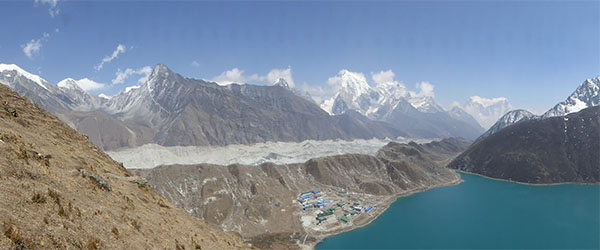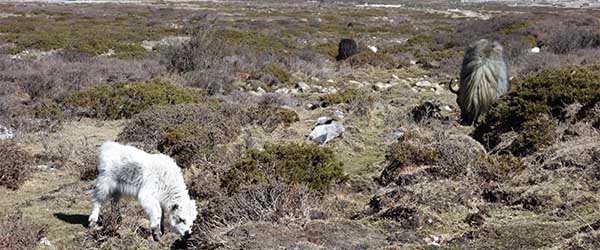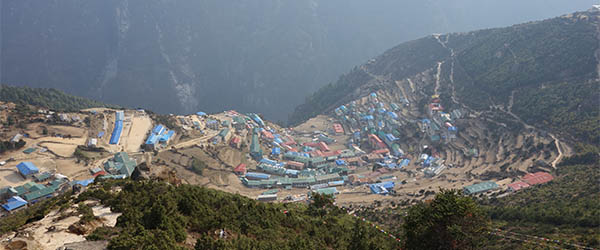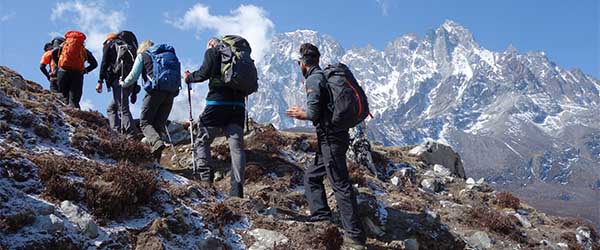The Sagarmatha National Park is a UNESCO World Heritage Site that encompasses 1,148km2 of land in the Himalayas of eastern Nepal.
The word, Sagarmatha, is the Nepali word used for Mount Everest (Mount Sagarmatha) and is derived from the two Nepali words of sagar, meaning ‘sky’ and matha meaning ‘head’. Everest is the western name given to the mountain and to the surrounding region.
The Sagarmatha National Park is the highest national park in the world with its lowest point standing at just over 2,800m and its highest, the peak of Everest, at just over 8,800m. The park contains a unique combination of forests, barren land and snow-capped peaks that are called home by the 6,000 or so indigenous Sherpas and by the variety of animals in the region.

Since the park was established in 1976 and inscribed as a world heritage site in 1979, the number of tourists visiting the region annually has increased drastically. From roughly 3,500 in 1979 to over 30,000 annual visitors today, the park and its inhabitants have become increasingly reliant on tourism as a means of living.
The majority of visitors to the area are people looking to trek to Everest Base Camp or on one of the various other treks in the region, such as the Gokyo Lakes, Island Peak, or Three Passes treks.
[adinserter block=”2″]
EBC Sagarmatha National Park
Landscape

With an altitude range of over 6,000m, the Sagarmatha National Park landscape varies drastically from lush forests in the lower, southern regions to barren lands that make up most of the valleys and ultimately to the ice and snow of the uppermost parts.
If you visit the park, you will soon realise that the majority of your time will be spent on barren land over 5,000m interrupted by small outbreaks of grazing land. Above 5,800m you will be in snow territory where plants cease to grow and where only the brave and crazy dare venture!
Towards the west of the park, in the Dudh Koshi Valley, you will find the Gokyo Lakes – the highest freshwater lake system in the world. Apart from the popular lakes, glaciers are very common in the park with the Ngozumpa Glacier being the biggest in the Himalayas as well as the largest persistent body of ice in the world.
The main attractions in the park, however, are the 7 peaks, each over 6,000m, of Everest, Lhotse, Cho Oyu, Thamserku, Nuptse, Amadablam and Pumori.
[adinserter block=”3″]
EBC Sagarmatha National Park
Flora and Fauna

The lower zones of the park are characterised by the scented forests of juniper, pines and fir. As you move north and gain altitude, the forests stop and the vegetation thins out considerably except for some rhododendron covered hillsides in early spring. Even further up, the plants become dwarf-sized shrubs and eventually just mosses and lichens can be found.
Because the lower forests contain at least 118 species of birds, the park has also been declared and Important Bird Area by BirdLife International. More rare species of mammals are also to be found in the area, such as the snow leopard, Himalayan black bear and the red panda. Yaks are a common sight in the park, largely due to the Sherpas using them to transport goods up and down the mountains.
EBC Sagarmatha National Park
Culture

The Tibetan Buddhist Sherpas have inhabited the region encompassing the Sagarmatha National Park for the last four centuries. Their unique culture and religion has survived to this day and they continue to be the proponents of conservation of the park through their beliefs and through their inextricable spiritual ties with the land on which they live. The slaughtering of animals in the park is prohibited, so foods are largely grain and vegetable based.
The Sherpa culture is visible through the various monasteries dotted across the region as well as the mani walls (rocks carved with prayer inscriptions) and prayer flags that have become synonymous with Everest and the Himalayas.

The Sherpa people have become famous for their innate mountaineering abilities and expertise as a result of years of living at high altitudes and navigating through the region. They were, and still are, instrumental in any trek and climb in the park as they have accompanied almost every successful summit to the peak of Everest. It is widely believed that they have a genetic adaptation from living in such high altitudes that make them naturally better at climbing and coping in the extreme high altitudes encountered on a climb.
[adinserter block=”4″]
EBC Sagarmatha National Park
Tourism and the Future of the Park

By in large, the increase in the number of tourists visiting the park each year has had immensely beneficial impacts on the local people and the infrastructure in the region. Beginning with the building of Lukla Airport and countless schools after the summit of Sir Edmund Hillary and Tenzing Norgay, the influx of tourists has brought with them a steady flow of money and investment into the region.
Almost all the park is covered by 3G mobile connection and Wi-Fi is commonplace in the tea houses and restaurants, even at the highest altitudes. Many tour operators, both western and local, now run their businesses in the region and the Everest Base Camp Trek has become one of the most famous and popular in the world with over 30,000 annual visitors.
Safety on the treks in the region has improved to the point where only a handful of people die each year, mainly due to altitude related sickness or underlying problems. The summit climb is still very, very hard but has increased in popularity to the point where it is common to see queues of people waiting to reach the summit. This is despite the large death toll in recent years due to the two avalanches of 2014 and 2015 and of course the infamous year of 1996.
In recent years, the park has seen tourism taking its toll with an ever-increasing demand for new hotels, new trails, energy and more and more garbage being disposed. The ecology of the park is fragile, so we ask visitors to please be mindful and respect the long history of the park and its people.

Hi My husband and I are in our mid fifties.Very active and fir.When is the best time to visit park?what are the accomidations offered?food?
Thank you and regards from
Tel Aviv,Israel:))
Sharon and Jonathan Bakst
Hi Sharon, here are useful articles that answer your questions: https://ebctrekguide.com/best-time-to-trek-to-everest-base-campm https://ebctrekguide.com/food-on-the-everest-base-camp-trek, and https://ebctrekguide.com/teahouses-on-the-everest-base-camp-trek